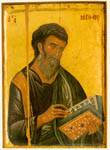|
|
| Portable Icons |
14th c., 3rd quarter Chelandari Monastery Wood, egg tempera, 100 x 67 cm |
|

|
St Matthew is portrayed from the waist up turning three-quarters to his left. He holds a half-open Gospel in his left hand and wears an aubergine tunic and dark green himation. On the gold ground of the icon is the inscription: 'St Matthew'. This sturdy figure, with the broad burly body, robust neck, and serene, profoundly spiritual expression tinged with sadness, traces its origin to early Palaeologan works of monumental painting, such as the frescoes in the Protaton (ca. 1290; Millet 1927, pls. 36-7). However, this St Matthew has a more direct typological and stylistic connection with the Matthew in Vatopedi Cod. no. 16 (1340-1), which was given to the monastery by Emperor John VI Cantacuzenos (Lamberz 1996, pp. 568-9, fig. 506). From a technical point of view, the volumes of the face are full and fleshy, rendered in a painterly manner with limited olive-green shading, a warm wheaten colour for the flesh, and broad, localised, supple highlights that give the face a luminous sheen. The joints of the long, shapely fingers too are rendered not schematically, but in a painterly manner. The beard and hair fall in flame-like, supple locks. The drapery, wide and flowing with patches and lines of highlighting, reveals the breadth and bulk of the body beneath. Similar techniques in the rendering the face, the areas of bare flesh, and the drapery are seen in the Apostles in Vatopedi Cod. no. 16 (Lamberz 1996, fig. 506. Kadas 1996 (1), fig. 544) and in the Great Deesis icons in Vatopedi Monastery (Tsigaridas 1996 (1), pp. 384-6, fig. 326), among others. The physiognomical and stylistic affinity between this icon of St Matthew from Chelandari and the miniatures in Vatopedi Cod. no. 16, and particularly the Great Deesis icons in Vatopedi, suggests that the Great Deesis icons in both Chelandari and Vatopedi were produced by the same workshop. They reflect artistic trends of the third quarter of the fourteenth century, which manifested a return to iconic types of the early Palaeologan period (Tsigaridas 1996 (1), p. 386). Furthermore, the sublime spirituality of the figures and the artistic links between the Chelandari Great Deesis icons and the Evangelists in Cod. no. 16 allow one to venture the opinion that both the Chelandari and the Vatopedi Great Deesis icons are expressions of the Hesychast spiritual movement and were produced by a workshop from Constantinople, which continued the techniques used by the workshop that produced Vatopedi Cod. no. 16 in 1340-1.
| |
|
Bibliography: Radojcic 1955 (1), p. 175. Chatzidakis 1956, p. 280. Xyngopoulos 1957 (1), p. 131. Djuric 1960, pp. 333-51. Weitzmann et al. 1966, p. LXVIII. Bogdanovic - Djuric - Medakovic 1978, p. 108, fig. 81. Weitzmann et al. 1982, pp. 141, 188, 190. Mueller - Djordjevic 1984, pl. 26. Djuric 1989 (1), fig. 10. Vocotopoulos 1995, pl. 119.
| ||
| E.N.T. | ||
| Index of exhibits of Monastery of Chelandari 14th century |
||
Reference address : https://www.elpenor.org/athos/en/e218ab27.asp